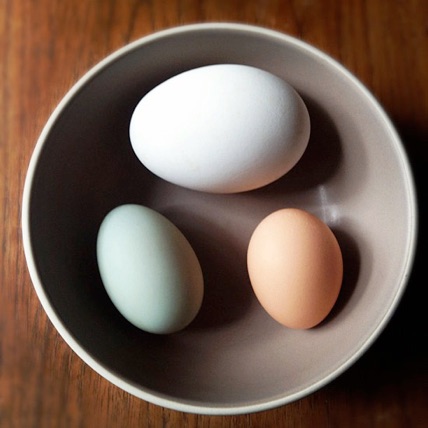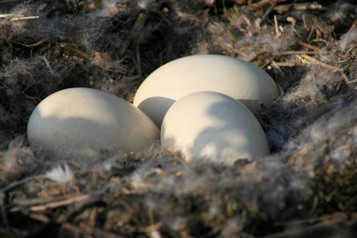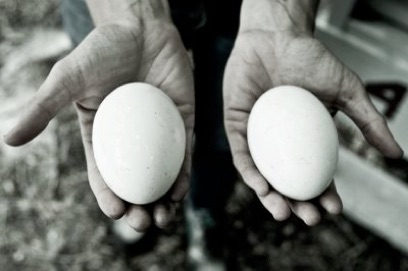About Goose Eggs

Goose eggs are not just extra-extra large chicken eggs. They are different in many ways from chicken eggs, and have their own distinct characteristics. These characteristics must be taken into account when writing goose egg pysanky.
SIZE: Goose eggs are much larger, for the most part, from chicken eggs. The actual size of the egg varies depending on the variety of goose. The smallest goose eggs are a bit larger than jumbo chicken eggs; the largest are huge. You can see the size range in this photo from Metzer Farms:

The eggs are measured along the long diameter; the result are in inches of circumference. A large chicken egg measures about 6 inches around. The photo below, taken from a food blog, shows a medium sized goose egg beside two chicken eggs (araucana and brown).

Finding patterns for such a large egg can be problematic. The UGS books have a few step-by-step goose egg patterns in them, particularly the design books. The books of traditional eggs (Elyjiw, Manko) don’t have any goose egg designs. Many books of art eggs and “modern” pysanky (Badulak, Horodetsky, Zahays’ka et al) have photos of goose eggs, but these are often quite complex designs.
Most pysankarky adapt chicken egg patterns or create new patterns for goose eggs. You could simply write a chicken egg pattern on a goose egg, and there are many people who do so, but this would be a waste of a nice goose egg. It is better to add or repeat elements (bands, etc.). In other words, add more, rather than just make what you have bigger.
SHAPE: Goose eggs are generally longer and narrower than chicken eggs. When I crop photos, I crop those of chicken egg pysanky to 8 x 10, and of goose egg pysanky to 4 x 6. Keep this in mind when choosing a design–bands should be easy to adapt, but motifs that are circular in shape (e.g. stars/ruzhi) might end up with odd proportions.
One solution to this is to divide differently. When writing the sorokoklyn design on some goose eggs, I have found that the triangles become quite long and unaesthetic looking. That can be fixed by subdividing some of the longer triangles, e.g. where one would normally divide a triangle into two when going from chicken (48) to goose (96), divide it into three. This would give you 14 triangles per wedge, rather than 12, and 112 overall.
Similarly, when writing a barylka, it might be necessary to have more bands around a goose egg than around a chicken egg. Otherwise the bands will be too wide, and the design elements in them disproportionate.
SHELL: The shell of a goose egg is both thicker/stronger than that of a chicken egg, and it usually absorbs dye more readily. This means that goose eggs are easier to etch, and will give lovely, bright colors.
It is not just because goose eggs are not sold in grocery stores, but in markets and on farms, and thus have not been handled and cleaned by machines, that the dyes take so well–it is the nature of the shell. Colors take quickly, and may be darker than you’re used to. Be vigilant, and don’t leave goose eggs in the dye too long.
Conversely, the egg really, really hates to give up dye. It is hard to remove green or blue colors with an orange rinse, so spot dyeing is necessary if you want to use these colors.
Big Honking Eggs





